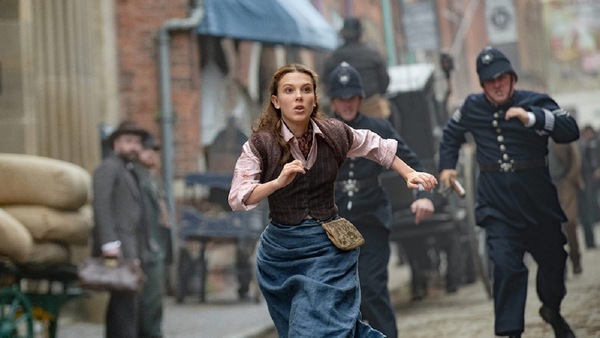How Enola Holmes 2 Speaks To The Mindful Magic of Millie Bobby Brown
Enola Holmes 2 is the preppy and peppy sequel to Netflix’s 2020 hit. The one-line premise: Enola opens her own detective agency and lands a missing-girl case.

Last Updated: 12.56 AM, Nov 05, 2022
There’s something about Millie Bobby Brown. She is young and talented and has a great film face, all of this is true, but she also displays a unique reading of literary girlhood. A bit like Hailee Steinfeld in Dickinson, where the performer counts on the fact that we can detect her cheeky revisionist ways. In Brown’s hands, Enola Holmes becomes the sort of Victorian-era teenager who has no qualms behaving like she’s from the future. It’s almost as though her Enola has grown up reading Nancy Springer’s young adult fiction series, of which she herself is the protagonist. Her morals are very millennial-esque, shaped by a wink-wink wokeness that can only come from post-internet living. Her Fleabag-style breaking of the fourth wall, then, feels oddly natural, like a 19th century version of tweeting and over-sharing. When she wonders aloud about why girls need chaperones present when they speak to boys, it’s a bit like us looking at period dramas through a modern lens. She knows it. The makers know it. We know it. And it works.
It’s this Millie Bobby Brown effect that also defines the language of Enola Holmes 2, the preppy and peppy sequel to Netflix’s 2020 hit. The one-line premise: Enola opens her own detective agency and lands a missing-girl case. Naturally, she uncovers far more than she bargained for. Her journey features her famous brother Sherlock Holmes (Henry Cavill), a matchstick factory, a financial scam, imprisonment, a romantic interest and an inspiring real-life figure. The sequel isn’t as plotty and dense as the first one, streamlined by the girl’s desire to step out of her brother’s shadow without totally escaping it. The mystery itself is a bit stretched in parts – especially during an endless ballroom sequence spread across three separate threads. Some of the action sequences plod along, too, relying far too heavily on physical punchlines. But the final payoff is satisfying, both at a narrative and psychological level, because it somewhat updates the Arthur Conan Doyle template in its quest for cultural renovation.
One might argue that Victorian-era London goes out of its way to depict racial and gender diversity in order to appease the film’s 21st century viewers. For instance, Adeel Akhtar plays Inspector Lestrade; Enola’s landlady is Black, as is a victim; two key Sherlock Holmes figures emerge as people of colour. While this is welcome in fictional renditions, several period movies run the risk of distorting the flaws of history in their search for new-age credibility. The Brown effect, though, is why the representation angle in Enola Holmes 2 doesn’t feel forced. Brown’s Enola is so self-aware and unapologetic about being ahead of her time that the film merely follows suit in other departments. Her relationship with her brother, for instance, is rooted in her preconceived understanding of their differences — he is a mechanical genius, while she is more empathetic and invested in the world she sets out to decode. She knows that the spotlight will be on him, which is why she hesitates in asking for help; her independence is nearly readymade. Most of all, she uses the invisibility of her gender to her advantage, blending into environments without inviting suspicion or scrutiny. She is acutely aware of the fact that society is conditioned to underestimate — and look through — her.
So when her eccentric mother reappears to rescue her from certain death, it’s not all that strange. When Enola’s solving of the case unveils a real-life historical figure whose revolution is bigger than her, the feminism is organic. And when Sherlock’s case gets intertwined with hers, revealing a formidable and famed enemy, the identity of this person is appropriate — hidden in broad daylight — mirroring the societal gaze that allowed Enola to operate under the radar. Just as Enola Holmes weaponised her own anonymity, the villain weaponises Enola’s (white) privilege. It’s a neat twist, and one that situates Enola’s heroism in a world that is both progressive and regressive at once. The body is old, but the soul is very much new. The men are there, but the women take great pleasure in their power as genre-fluid and sensibility-forward beings.
The expanded role of her brother also becomes a ruse for Enola’s own sense of agency — we are so busy looking for easter eggs in Sherlock’s early years that Enola Holmes joins the dots right under our noses. The idea, going forward, is to perhaps fashion Enola as the more pressing and humane dimension of the Sherlock story. He is no male saviour; on the contrary, she is perhaps destined to save him from himself. The writing derives glee from her presence in his life. It’s easy to want the story to be only hers, but the truth is that it’s Enola’s job to reclaim the narrative every time it veers away from her. Her surname is going nowhere, for better or worse, and so it’s only fitting that she plays both the supporting act and the aspiring hero of her own life. If we aren’t okay with it, Millie Bobby Brown will simply do that thing where she looks straight at us and assures us that she knows. She always knows.
Enola Homes 2 is now streaming on Netflix.
